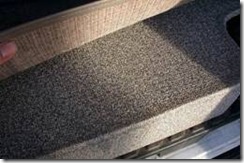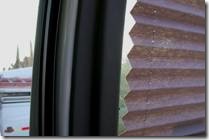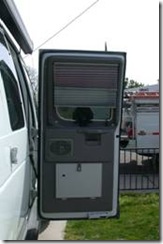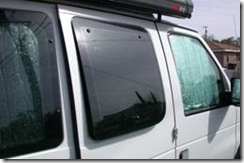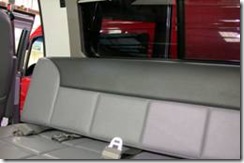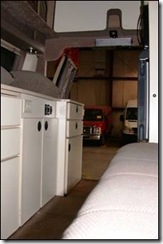By Dave Boyer
 I finally put my van to the test and made a trip to the Autoramblings headquarters located in Fort Collins Colorado (that would be Lloydís house). This is the longest run I have ever made to date with my 2006 Sportsmobile. The trip was great other than the out of control fuel prices and no off roading. To tell the truth as much as I wanted to hit some dirt, locking up the hubs was not part of the schedule during this excursion. The journey was a little hectic but at least I found out how many miles I could cover in a limited time frame. Because I wanted to have a few camp fires along the way I brought my SMB Rock Crawler trailer along loaded with wood. At any rate I wouldnít have to go looking for wood and the fires along with a few brews became a nice way to end the day. The two week tour from central California started with the first night on Sonora pass boon docked on Eagle Meadows road with some friends. Great Basin National Park in Nevada was on the next dayís agenda. After Nevada I was off to Utah looking for a spot to camp along the Colorado River near Moab. Arches and Canyonland National parks were near by but the hot weather was catching up with me. Because I am planning a trip next year while itís a bit cooler I decided to spend the night along the river and leave early the next morning. From there I drove to Colorado and stayed several days on the Poudre River near Fort Collins. With temperatures around 90 degrees at 8:00 AM the day I left Utah, it was a welcome site waking up to find snow falling at my camp site along the Poudre river. Eventually I met up with Lloyd and we spent several days exploring Rocky Mountain National Park. According to Lloyd we took the van over the highest thoroughfare in the lower US at 12,200 feet and although the pass was packed with vehicles it ended up being an extremely gratifying run. After returning Lloyd to his wife I had some extra time before returning to California so a trip through Wyoming seemed fit. One picturesque pass is highway 130 above the town of Centennial where I spent one night in a great little campground up the road a ways. The next day while trekking towards Yellowstone I drove over the upper portion of the pass frequently called ďSnowy Mountain???. It was breathtaking at this time of year with a large amount of snow, plus the pass had a lake that was frozen over which was a bit of a surprise coming from California. From where I camped along highway 130, Grand Teton National Park and neighboring Yellowstone was about eight hours away. After finding a nice campground in Teton national park, I spent just enough time to realize that both of these parks deserve more time to explore than the time I had allotted. As a rule Iím not in to the tourist traps, but Yellowstone in general is something to see. The Grand Teton range on the other hand offers a little more privacy and a few dirt roads to check out. Both parks are well worth taking the time to visit. But this was a road trip and after a couple of hectic days, I was off to re-visit Great Basin National Park. This park offers a chance to beat the heat compared to the surrounding area especially if you take the cave tour which is what itís famous for. From here itís only about 10 hours to upper Yosemite or Sonora pass. Unfortunately I decided on Yosemite and found everything closed in the upper section forcing me to head towards home. I now know I can drive from the Nevada/Utah border to Central California in 12 hours. Being able to set up and tear down quickly, coupled with reasonable fuel mileage and off road capabilities makes my Sportsmobile a great choice over a standard large RV.
I finally put my van to the test and made a trip to the Autoramblings headquarters located in Fort Collins Colorado (that would be Lloydís house). This is the longest run I have ever made to date with my 2006 Sportsmobile. The trip was great other than the out of control fuel prices and no off roading. To tell the truth as much as I wanted to hit some dirt, locking up the hubs was not part of the schedule during this excursion. The journey was a little hectic but at least I found out how many miles I could cover in a limited time frame. Because I wanted to have a few camp fires along the way I brought my SMB Rock Crawler trailer along loaded with wood. At any rate I wouldnít have to go looking for wood and the fires along with a few brews became a nice way to end the day. The two week tour from central California started with the first night on Sonora pass boon docked on Eagle Meadows road with some friends. Great Basin National Park in Nevada was on the next dayís agenda. After Nevada I was off to Utah looking for a spot to camp along the Colorado River near Moab. Arches and Canyonland National parks were near by but the hot weather was catching up with me. Because I am planning a trip next year while itís a bit cooler I decided to spend the night along the river and leave early the next morning. From there I drove to Colorado and stayed several days on the Poudre River near Fort Collins. With temperatures around 90 degrees at 8:00 AM the day I left Utah, it was a welcome site waking up to find snow falling at my camp site along the Poudre river. Eventually I met up with Lloyd and we spent several days exploring Rocky Mountain National Park. According to Lloyd we took the van over the highest thoroughfare in the lower US at 12,200 feet and although the pass was packed with vehicles it ended up being an extremely gratifying run. After returning Lloyd to his wife I had some extra time before returning to California so a trip through Wyoming seemed fit. One picturesque pass is highway 130 above the town of Centennial where I spent one night in a great little campground up the road a ways. The next day while trekking towards Yellowstone I drove over the upper portion of the pass frequently called ďSnowy Mountain???. It was breathtaking at this time of year with a large amount of snow, plus the pass had a lake that was frozen over which was a bit of a surprise coming from California. From where I camped along highway 130, Grand Teton National Park and neighboring Yellowstone was about eight hours away. After finding a nice campground in Teton national park, I spent just enough time to realize that both of these parks deserve more time to explore than the time I had allotted. As a rule Iím not in to the tourist traps, but Yellowstone in general is something to see. The Grand Teton range on the other hand offers a little more privacy and a few dirt roads to check out. Both parks are well worth taking the time to visit. But this was a road trip and after a couple of hectic days, I was off to re-visit Great Basin National Park. This park offers a chance to beat the heat compared to the surrounding area especially if you take the cave tour which is what itís famous for. From here itís only about 10 hours to upper Yosemite or Sonora pass. Unfortunately I decided on Yosemite and found everything closed in the upper section forcing me to head towards home. I now know I can drive from the Nevada/Utah border to Central California in 12 hours. Being able to set up and tear down quickly, coupled with reasonable fuel mileage and off road capabilities makes my Sportsmobile a great choice over a standard large RV.
The air conditioning unit
Since the writing of this portion, SMB now offers a different air conditioner system made by Danhard. Changes and upgrades are common with modifications in the industry. I may discuss the newer options introduced by SMB from time to time, but please understand that I will not be able to comment how well any new devices or systems operate from a first hand basis. I plan to add a page of upgrades at the end of this article. If someone points out any pros or cons I will gladly post what Iíve been told. BTW Danhard did manufacture the Starcool system which is no longer available.
A few new owners have mentioned that the Danhard air conditioners are an improvement over the Starcool system that came with my vehicle.
http://www.danhard.com/
There is also some good information in this PDF file from Dometic.
http://www.dometictruck.com/pdf/L-2523.pdf
Starcool operation
Another big and expensive option is an additional add-on air conditioner system. The Starcool air conditioner system is the unit that was installed during my vehicleís construction. Itís a supplemental air conditioner, not the factory Ford A/C that comes with the vehicle. I have been told that there are a couple different versions but I will be keying on my unit which is classified as the Starcool III. Living in a hot climate during one third of the year was a sure sign that the Starcool option was going to be a definite addition to my vehicle. It works very well at cooling down the vans interior quickly, and according to SMB it takes some load off the stock A/C system. The Starcool III (which I will abbreviate as SC) has the ability to operate while driving or while plugged into shore power. On the road the two systems, both the factory and SC should be operated together. I have been told that the stock Ford system and the SC are tied together and use the same coolant system. It is up to you how to set the rear SC fan speed to the level needed. On my vehicle, the Starcoolís primary activation switch is located on the wall behind the driverís seat, so you can turn the system on when you start the engine and need cool air. The fan control switch is located in the mid section close to the sink. It has 4 settings for air flow (off, 1, 2, and 3, the maximum fan speed). The rear fan control should be switched to one of the 3 fan settings other than off. The primary switch is used to turn the system on and off. This might be kind of an inconvenience having to reach over your shoulder to activate the system but it works fine for me. When the weather is real hot I set the SC fan to the highest setting and adjust the stock front A/C for the desired comfort level. When the weather starts to cool off a bit I might lower the SC fan to keep the cold air from blowing down my neck while driving.
Shore power and alternating current
I have been told you can order a Starcool system that runs only off 110V AC shore power. From what I gather it is a standalone unit that does not use DC voltages. You will have to check with SMB if they (still) offer this. With my unit I can do both, that is, run it off the vehicles 12 VDC system while driving, or park where 110 VAC available. In the AC mode it acts just like an air conditioner in your home. Just remember that you will need at least a 30 amp power plug, extension cord and service box to connect to the van. A small typical house plug will normally not be rated high enough for this amperage and may cause damage to the Starcool. On top of that AC is polarized. In other words there is a hot and neutral side to a typical plug. Verification of this is important before you ďplug in???. Never use the wrong pig tail to connect to shore power. A pig tail or extension cord must have the correctly rated plugs and wire which can handle the necessary loads that the SC pulls. Cutting off the ground lug can cause all kinds of trouble for you, one being reverse polarity. Itís possible to energize the van and be shocked by making the latter mistake. The box you plug into can also have a polarity problem. Polarity can be checked with a cheap tester that I will discuss below. Another issue is an extension cord that is too long or coiled up. The main problem with this is low voltage. Itís important to use the right cord, the best being one that is as short as possible, the correct gauge, and never use it if itís coiled up. While it is OK to charge batteries, run lights, or fans via a standard household plug, the Starcool must not be operated with this type of connection. Operating larger portable electric heaters, the microwave (for long periods of time) and especially the Starcool is not advised using less than a 30 amp service. Even worse disregarding this might start a fire due to overload. Most RV parks offer 30 to 50 amp plug in stations at minimum, but you will need to verify this. Donít attempt to run the air conditioner off a 20 amp circuit. 110VAC is a misconception. True AC voltage is between 115 and 127. Dropping below 115 is not recommended. Because there is no such thing as guaranteed clean voltage, it is important to test and monitor shore power. There are several devices to check this and in fact most high end inverters will warn you of ďdirty??? power. But systems such as the Starcool which run off the shore power directly (not through the inverter) can be damaged if the voltage is not up to correct specifications. Therefore it is advisable to have some sort of protection that will automatically disconnect you from the grid power if something goes wrong. As far as polarity testers, cheap ones are OK for testing it but usually do not protect your investment from low/high voltages or if a failure occurs while connected to shore power. Just because a shore power pedestal looks correct doesnít mean it has service wire thatís adequate to keep the voltage up, so itís important to test the voltage under load. While itís not possible to sit there and look at the voltage gauge while asleep, chances are if you check it under maximum load you should be good to go. I might be over reacting here a little, but itís better to spend a dime to save a dollar. Iím an electrical trouble shooter for a power company and thatís what I do for a living. Many times I have responded to trailer parks (or other electrical customers) where the owner has lost several high dollar items do to poor power. Trailer parks are notorious for having poor electrical systems that fail on a regular basis. Shore power at a resort is no different. Test it, monitor it, and supply your own protection! This link is good to read.
http://www.zapfreerv.com/
A friend who is a qualified A/C mechanic told me that most air conditioners are designed to work on voltages of +/- 5% of 120 volts. Although many things are designed to work on sub-standard power, it puts unnecessary stress on some items. Shoot for voltages between 115 and 125, preferably 120 volts which is a good voltage that most electrical devices like. Below are some links to protection devices. Just remember that most surge protectors deal with high voltage only and long run times at low voltage can be just as bad. The reason high voltage is a big issue with surge protectors is it destroys electronics where as low voltages donít pose much of a problem.
Larger RVís that are left unoccupied usually need something that doesnít permanently trip off line until reset. Returning home to warm food in the refrigerator is not a plus. The problem is that some of these devices will only cutoff or ďclamp??? voltages when they are too low or too high for compressors. The Starcool shouldnít be subjected to these voltages. A monitor which has an alarm that can be preset to notify you when the voltage meets the preset parameters would be an additional benefit. Unfortunately these monitors seem harder to find as compared to their DC counterparts. Do a search for the right item that suits your needs. Here are a few typical RV surge protectors design to help your RV, just donít think they are a guaranteed solution.
http://www.campingworld.com/shopping/item/rv-surge-protector-circuit-analyzer/35145
http://www.campingworld.com/shopping/item/digital-line-monitor/24900
http://www.pplmotorhomes.com/parts/rv-power-cords/rv-surge-protector.htm
Now in reality a Sportsmobile isnít like a diesel pusher and I would be perfectly content with a good voltage monitor and surge protector. Most owners operate off DC and donít usually hook up to shore power unless they are at home charging or need the air conditioner because itís hot. I wouldnít worry about all the high dollar protection devices because most of the time you will catch the problem before it causes major damage provided you do some testing before and after you hook up. If youíre a full timer and move from spot to spot it might be more of a concern. But look at the odds. How often have you had a bad experience with your electrical panel at home? I would venture to say most have not, and even if you did how many times? Itís very rare when I have to return to the same residence to trouble shoot a problem. So donít worry, just test it, monitor it, and supply your own protection!
I havenít had too many problems with the Starcool system but have yet used it when plugged into shore power. I have been told that it cools relevant to the outside air temperature. This is better than nothing, but in hot weather it might not be up to par for those looking for a 65 degree environment while itís 105 outside. But remember I havenít tried it yet. One Forum member claims he can get his van down to the lower 70ís with outside temps hovering around the upper 90ís using the Starcool A/C on shore power. Another owner claims that their new Danhard unit is more efficient and will bring the inside temperature down to 70 degrees in 100+ weather. HmmÖmaybe a change for me in the future. Iím sure how the van is insulated makes a big difference and more people are requesting better insulation these days. My plan from day one was to install a 50 amp service close to where I park to serve as a home shore power port. With that I can run the SC during the day before leaving on a trip keeping the van at a reasonable temperature.
As for the Starcool III, as a vehicle air conditioner, it has its share of hours put on it in my rig. The SC combined with the stock A/C works quite well. My biggest gripe is where they mounted the primary system switch. Like I said, I donít have a problem reaching over my shoulder to turn it on and off, but if I were to order a new van I would insist that an indicator light be put on the dash that shows the system is running. Because the primary switch must be turned on even when youíre plugged into AC power, itís mounted for access from the mid section of the van as well as the driverís seat. Activating this switch will keep the fan running even if the ignition is off. If you forget to turn off the primary and fail to hear the fan running after exiting the van, you will end up with a dead house battery within a few hours. This generally happens to me when I get out of the van while the stereo is cranked up loud. Although I havenít killed my house battery yet an indication light on the dash would be nice. The SC does pull a fair amount of DC amperage off the vehicleís charging system also. I upgraded my alternator to a 200 amp version in part because of this, but itís not required. The larger alternator gives the ability to run the SC along with other systems the van needs while still providing a good charge current to the house battery.
There is no way I would be without the Starcool or some other type system, but I like to avoid heat at any cost and boy does this setup cost. I donít know how prices stack up between Danhardís new unit and SC, but Danhard has been making climate control systems for truck drivers and ambulance companies which I would think is a plus as far as reliability. Talk is that that the new Danhard air conditioner that SMB is using has a lower DC draw and can run off a 2000 watt generator where the SC needs about 3kW. More and more people are verifying this but I still donít have any information on battery operation. My thought is it still would require a very large bank of batteries to operate for any extended length of time.
The Starcool III is a complicated system with stuff running all over the place. It could give Ford a reason to complain about working on your stock air and not honor your warranty. And because this add on equipment is tied to the stock OEM system, it might make normal maintenance more difficult for mechanics. I could see this becoming a reason to charge more for repairs to the stock system when it might not have anything to do with the Starcool A/C at all. They might even refuse to work on your vehicles A/C altogether. So far I havenít had Ford hassle me about it. Only time will tell how it holds up and whether it causes other problems with the stock van system. I lost the coolant in mine and had to take it back to SMB. If Ford would have even considered working on it, I wouldnít have wanted to see the bill. Personally, Iíd prefer to have a standalone system that has nothing to do with the stock air conditioner. Iíve been told the Danhard is an individual system and would think it would be a good choice being itís fairly small. Unfortunately size matters and most other individual air conditioners are big bulky units that sit on top of the vehicle and need shore power. California has passed a clean air law about how long a diesel can idle. It stabs at truck drivers who pull over to sleep while on the road. This law will probably promote advancements in climate control systems that require less power and/or smaller sized units to be made available in the near future. As I said earlier, most Sportsmobileís donít have the room for a large enough battery bank to power an air conditioning system overnight. Hopefully improvements in battery technology will move forward in the upcoming years with companies developing smaller batteries that deliver more power. The new Danhard system looks like itís designed to address load problems, but again I havenít researched it much. More than likely youíll still require a generator or shore power to run it all night.
Other less expensive options are out there such as swamp coolers and ice chest type coolers. Maybe youíre the type of person who isnít affected by heat like I am. Portable 12 volt DC fans can help and pull about 3 amps. Some of these might be an option.
http://www.swampy.net/
http://www.campingworld.com/shopping/item/fan-tastic-endless-breeze-12v-fan/38132
The sink and counter tops

The model usually designates how the sink area is set up but it can also be custom made to fit. Some kitchen areas utilize standard counter tops but many incorporate Corian. Sinks can be ordered in stainless steel if itís preferred.
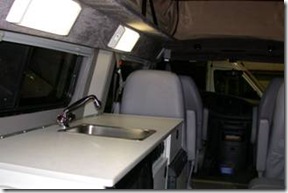
In my EB-50 plan, the sink and counter tops are both made of Corian.

Corian does make for a rather nice upgrade but beware that it can be scratched. A little wax will touch it up. Some owners opt for a small pedestal type sink area. This is your choice when placing an order. A pedestal sink is often preferred by those who are setting up their van for transportation needs and need maximum space savings. A sink is usually accompanied by a gray water tank. Some exclude this tank from their design plan for a variety of reasons but itís usually to gain space, save weight or reduce the overall cost. As I have already said, the sink is a plus to have for many reasons.
Normally the standard propane stove is installed in the counter top next to the sink and SMB now offers a flush mount stove that looks great, but if you have followed this article you know I opted out of the propane system. To have hot water you must have one of the options to heat the water that has already been discussed. Again to qualify a van conversion as an RV, running water, a sink, and a holding tank helps make the requirement.
The Bath
SMB offers a variety of ways to set up a bath area inside the van. This was probably the least important option for me. Being the kitchen sink is a standard item, I have an area to wash up, brush teeth as well as wash dishes. I have no use for an inside shower because of the room they take up. And because of the room I take up, they probably donít make one big enough for me anyway. Submarine showers are fine but Iím sure the ladies will not agree on this. The outdoor shower wand was a good choice. Called the exterior shower, this shower wand can be installed in a variety of locations. I opted for the standard location at the right rear side of the van. Open the back doors, pull out the shower wand, turn on the hot and cold water knobs on and burn your head off. The first time I used it I let out a blood curdling scream. Yes the hot and cold controls are a bit difficult to set, but you soon learn how to use them without hurting yourself. If the insects are not thick, I set up a shower curtain to keep water from splashing all over the doors and inside the van by using aluminum tent poles and cheap curtains from Wal-Mart. Some people use a sun shower and just fill it up with warm water from the sink, but the wand is handy. SMB now offers a better shower wand now and I am looking at a temperature control valve as well as an outside hookup. Being able to shower without the doors being open has some huge advantages if insects are buzzing around.
The Head
PORTA POTTI VS MARINE TOILET:

I purchased the porta potti, a device that I have yet to use. I guess Iím just scared of the thing but it is nice to have a backup in an emergency. I carry a privy tent that also doubles as a shower that I set up behind the van to shower in when I need a little privacy. At this time I use bio-bags rather than the porta potti in the privy. I might re-evaluate hauling the porta potti in the future especially during long trips when Iím on the road by myself but the cabinet itís stored in is a very valuable space. So for now I leave it at home and use the cabinet area to store a variety of items. A marine head canít be removed like a porta potti. Here again is another insurance snafu. Back to the gray area of what constitutes an RV. I donít think that a porta potti qualifies as a RV toilet but I could be wrong. This is something to take up with your insurer but even they can be misled by the fine print as I have pointed out in an earlier post. Insurance companies claim that too many people are saying that their standard vans are RVís so they can get cheaper insurance. It would be bad news to total out your vehicle and find that youíre not covered though. The standard marine head that SMB offers requires a black water tank and this too takes up valuable space under the vehicle. A dedicated bathroom inside the van takes up a lot of room, so it was not suited for me but Iím sure others disagree.
The Interior
XL STORAGE:
The most important item in this section is the XL storage area. This is one of the most useful items I had installed. It is a large area located at the rear of the vehicle where the spare tire is normally stored. SMB moves the tire outside and installs a larger water proof box that can be used as storage or even an ice chest. The bottom has a plugged drain hole to let the water out, but I use it for tools and equipment storage. It requires you to install a bracket to hold the spare tire on the rear of the vehicle. The only gripe I have heard is water getting into the storage area from outside the cab. It has never happened to me and Iíve been in some very wet conditions as well as a few streams.
THE SAFETY MIRROR:
The rear view mirror can be changed out to one similar to what comes standard in most high end vehicles. It has a compass, thermometer, and adjusts to bright car lights sneaking up on you at night. With tinted windows it doesnít really do much for dimming bright lights but the compass and temperature read out is a nice option to have. At over 300 bucks though, you can probably find a cheaper solution. It would be great to have a clock in it. I donít really know if I would order it again.
LUMBAR SUPPORT:
Another item I wasnít sure I needed was the lumbar support for the front seat that I already discussed. I am glad I requested this to be installed. This makes a big difference on long trips. Basically you just turn a knob which inflates a bladder type bag. Simple yet effective.
THE PORTABLE STOVE:
This was already discussed in detail. All I can say is it works OK and can be used on the counter top without heat damage to the top.
Thanks for reading Autoramblings and I hope these articles will be helpful. The next posting will go over some of the electrical systems.















